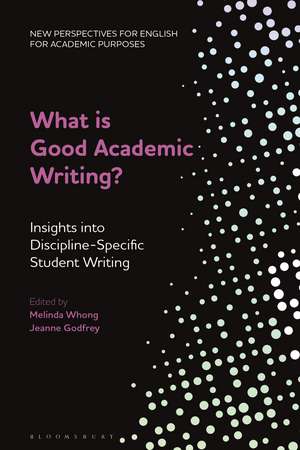What is Good Academic Writing?: Insights into Discipline-Specific Student Writing: New Perspectives for English for Academic Purposes
Editat de Professor Melinda Whong, Dr Jeanne Godfreyen Limba Engleză Hardback – 23 dec 2020
| Toate formatele și edițiile | Preț | Express |
|---|---|---|
| Paperback (1) | 196.96 lei 6-8 săpt. | |
| Bloomsbury Publishing – 29 iun 2022 | 196.96 lei 6-8 săpt. | |
| Hardback (1) | 597.44 lei 6-8 săpt. | |
| Bloomsbury Publishing – 23 dec 2020 | 597.44 lei 6-8 săpt. |
Preț: 597.44 lei
Preț vechi: 858.00 lei
-30% Nou
Puncte Express: 896
Preț estimativ în valută:
114.33€ • 118.64$ • 95.56£
114.33€ • 118.64$ • 95.56£
Carte tipărită la comandă
Livrare economică 15-29 martie
Preluare comenzi: 021 569.72.76
Specificații
ISBN-13: 9781350110380
ISBN-10: 1350110388
Pagini: 208
Dimensiuni: 156 x 234 x 19 mm
Greutate: 0.47 kg
Editura: Bloomsbury Publishing
Colecția Bloomsbury Academic
Seria New Perspectives for English for Academic Purposes
Locul publicării:London, United Kingdom
ISBN-10: 1350110388
Pagini: 208
Dimensiuni: 156 x 234 x 19 mm
Greutate: 0.47 kg
Editura: Bloomsbury Publishing
Colecția Bloomsbury Academic
Seria New Perspectives for English for Academic Purposes
Locul publicării:London, United Kingdom
Caracteristici
Explores disciplines that are not well researched, including design, digital media studies, music, creative industries, fine arts as well as dentistry, experimental linguistics, and maths and physics
Notă biografică
Melinda Whong is Associate Professor of Language Education, and Director of the Center for Language Education at the Hong Kong University of Science and Technology, Hong Kong.Jeanne Godfrey is Teaching Fellow at the University of Leeds, UK. She has held the positions of Head of Department, Principal Lecturer in Learning and Teaching, and Chair of BALEAP. She is the author of several EAP student books.
Cuprins
Series Editor ForewordIntroduction: The Good Writing Project, Melinda Whong (Hong Kong University of Science and Technology, Hong Kong) and Jeanne Godfrey (University of Leeds, UK)1. A Collaborative Scholarship Model of EAP Research and Practice, Jeanne Godfrey (University of Leeds, UK) and Melinda Whong (Hong Kong University of Science and Technology, Hong Kong)2. The Written Discourse Genres of Digital Media Studies, Simon Webster (University of Leeds, UK)3. Exploring Clarity in the Discipline of Design, Clare Maxwell (University of Leeds, UK)4. Musicology and Its Others, Karen Burland, Edward Venn and Scott McLaughlin (University of Leeds, UK)5. Good Academic Reflective Writing in Dentistry, Marion Bowman (University of Leeds, UK) 6. Dissertations in Fine Art, Sara Montgomery (University of Leeds, UK)7. Good Writing in Linguistics, Diane Nelson and Valentina Brunetto (University of Leeds, UK)Afterword, Ian Bruce (University of Waikato, New Zealand)References Index
Recenzii
This volume addresses one of the most important questions in English for Academic Purposes. The answers it provides are thoroughly grounded in practice, and presented in a way that will allow practitioners to apply them to their own writing classrooms. Taken individually, the chapters shed useful light on the textual features prized in a range of academic disciplines. Collectively, they provide an exemplary blueprint for practice-proximate work on the scholarship of teaching and learning.
What is Good Academic Writing? provides insights into student writing in specific disciplines where teaching materials tend to be difficult to obtain (new/digital media studies, design, musicology, dentistry, fine art and linguistics). Following best ESAP practice, the chapters combine EAP and subject lecturer perspectives. They also discuss topics of wider concern to EAP, such as clarity, criticality and reflection. Informed by current research, and written by engaged practitioners, they will appeal particularly to ESAP teachers and trainees.
What is Good Academic Writing? is a very welcome addition to the literature on disciplinary writing in academic settings. The chapters of the book provide insights into how good academic writing is perceived in different areas of study that will be of value to both academic writing teachers and subject area specialists. The book demonstrates the value of a focus on disciplinarity in the teaching of academic writing. It is also an outstanding example of collaborative research into the disciplinary nature of academic writing. I highly recommend it.
This is a book for all EAP practitioners with enquiring minds. It informs us about specific disciplinary writing practices, but it also demonstrates how we can keep on exploring these practices for ourselves, in any field where good academic writing takes place.
What is Good Academic Writing? provides insights into student writing in specific disciplines where teaching materials tend to be difficult to obtain (new/digital media studies, design, musicology, dentistry, fine art and linguistics). Following best ESAP practice, the chapters combine EAP and subject lecturer perspectives. They also discuss topics of wider concern to EAP, such as clarity, criticality and reflection. Informed by current research, and written by engaged practitioners, they will appeal particularly to ESAP teachers and trainees.
What is Good Academic Writing? is a very welcome addition to the literature on disciplinary writing in academic settings. The chapters of the book provide insights into how good academic writing is perceived in different areas of study that will be of value to both academic writing teachers and subject area specialists. The book demonstrates the value of a focus on disciplinarity in the teaching of academic writing. It is also an outstanding example of collaborative research into the disciplinary nature of academic writing. I highly recommend it.
This is a book for all EAP practitioners with enquiring minds. It informs us about specific disciplinary writing practices, but it also demonstrates how we can keep on exploring these practices for ourselves, in any field where good academic writing takes place.







